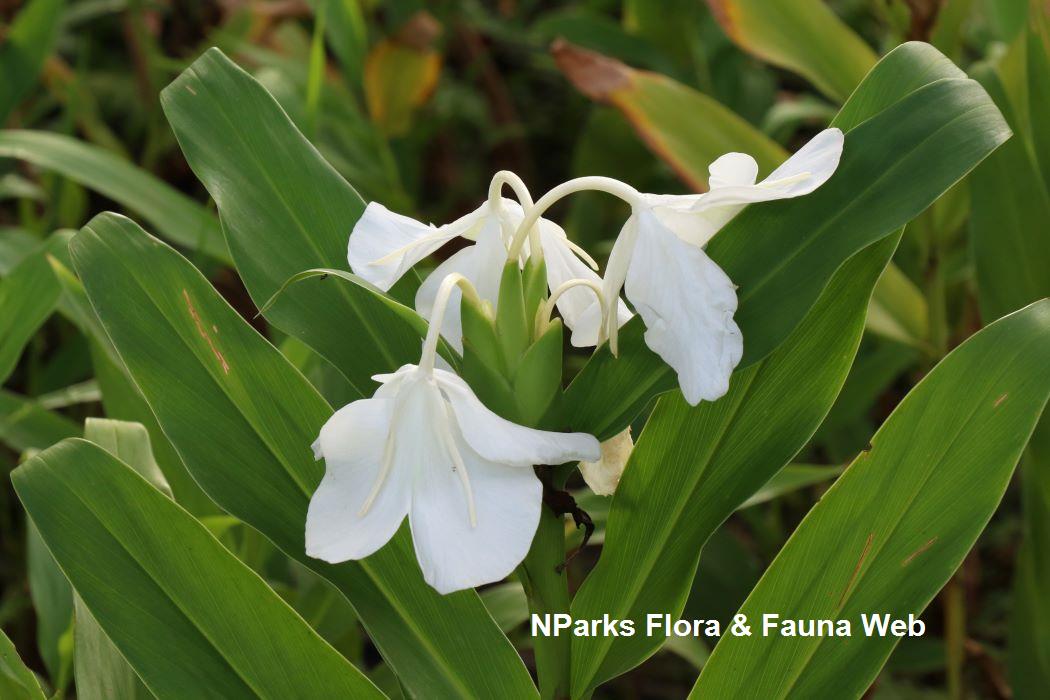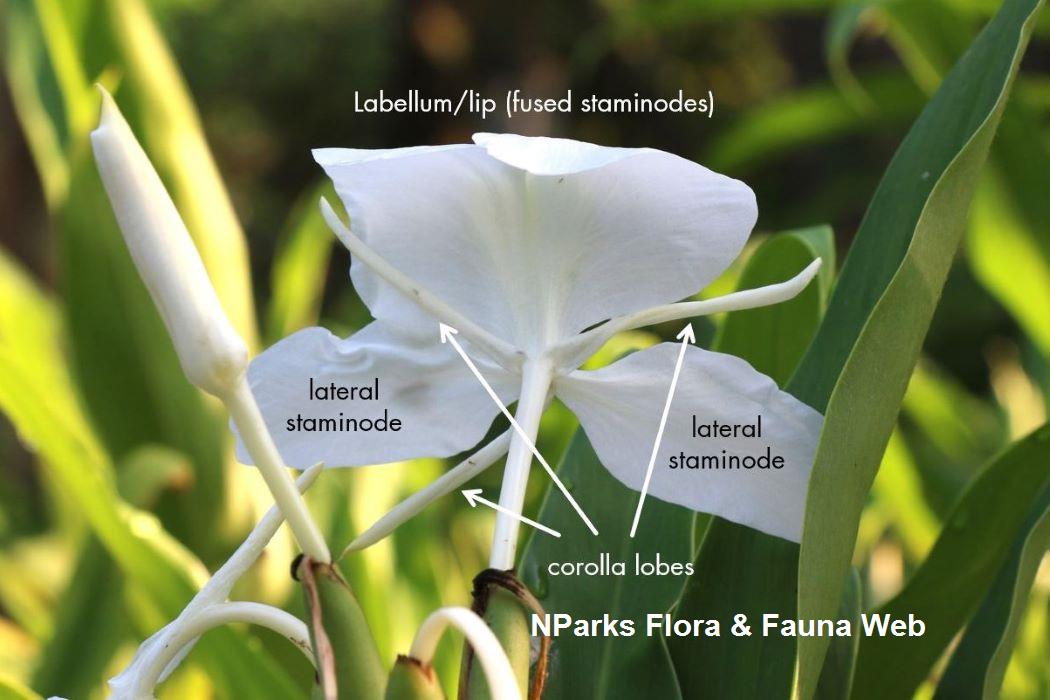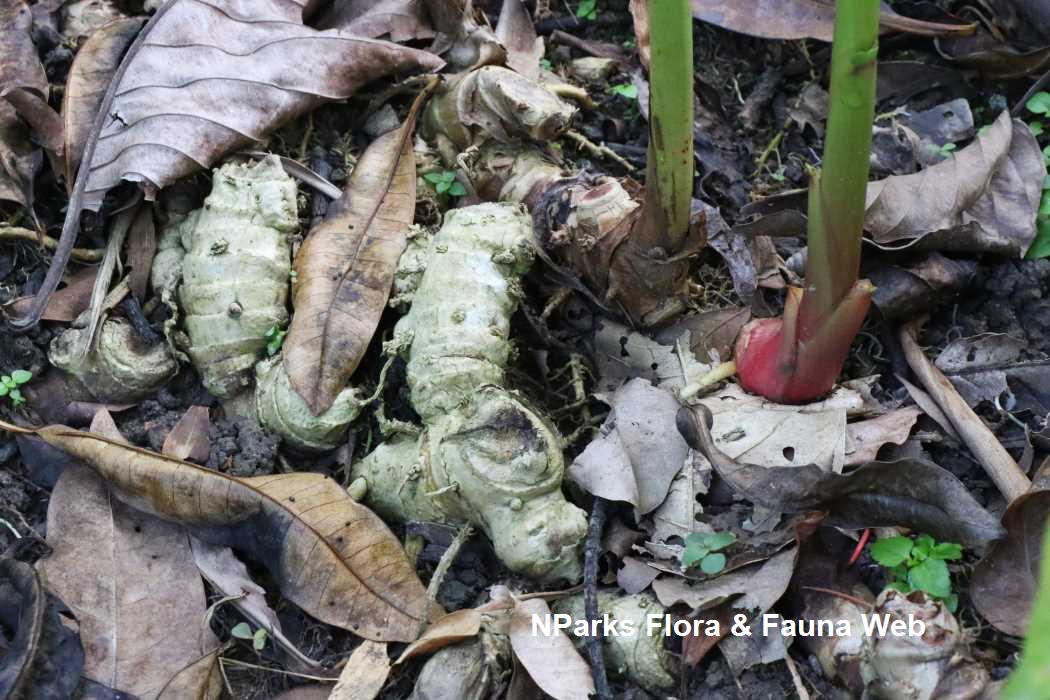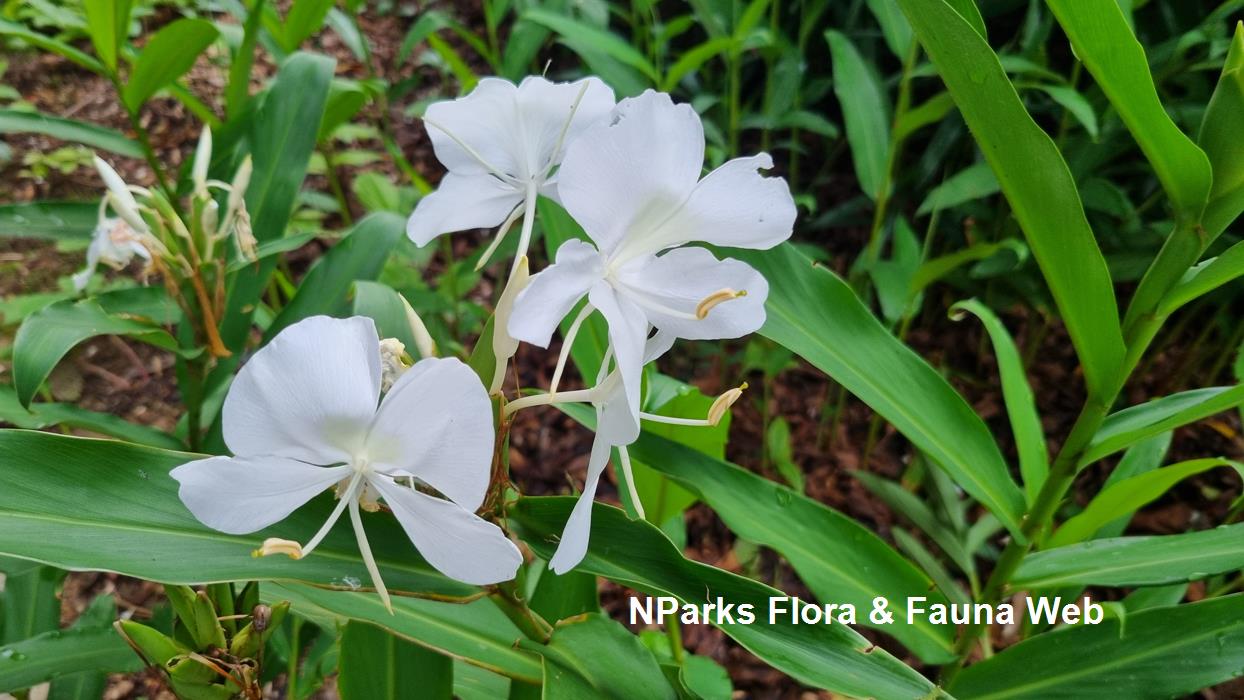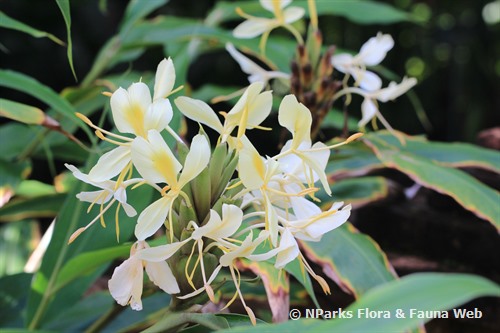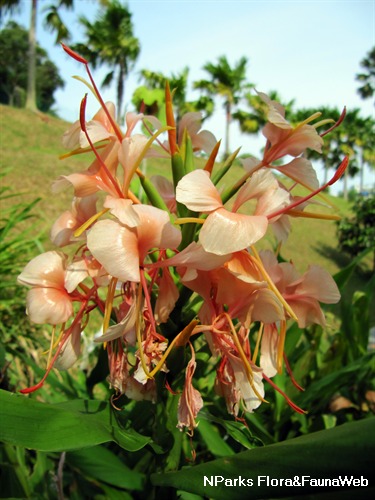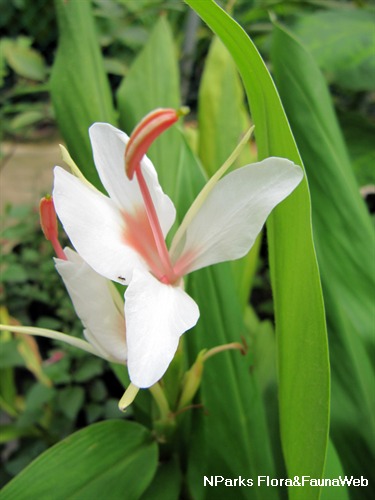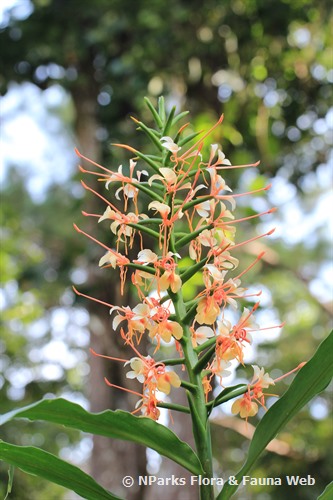.jpg)
Back
Hedychium coronarium J.Koenig
| Family Name: | Zingiberaceae |
| Synonyms: | Hedychium coronarium var. chrysoleucum (Hook.) Baker, Hedychium coronarium var. maximum (Roscoe) Eichler, Hedychium chrysoleucum Hook., Hedychium flavescens var. chrysoleucum (Hook.) C.E.C.Fisch., Hedychium gandasulium Buch.-Ham. ex Wall., Hedychium lingulatum Hassk., Hedychium prophetae Buch.-Ham. ex Wall., Hedychium sulphureum Wall., Amomum filiforme W.Hunter, Gandasulium coronarium (J.Koenig) Kuntze, Gandasulium lingulatum (Hassk.) Kuntze |
| Common Name: | Butterfly Ginger, White Ginger Lily, Garland Flower, White Ginger, Ginger Lily, Gandasuli, 姜花 |
The Butterfly Ginger (Hedychium coronarium) is a herbaceous perennial with pseudostems growing up to 1.5 - 2 metres tall. It is named after the white fragrant flowers that resemble the shape of a butterfly in flight. While grown in Singapore as an ornamental, the flowers are used extensively in garlands in India, Japan, and Hawaii, and can be eaten as vegetables or lightly steamed with chilli sauce.
Name
Classifications and Characteristics
| Plant Division | Angiosperms (Flowering Seed Plants) (Monocotyledon) |
|---|---|
| Plant Growth Form | Herbaceous Plant |
| Lifespan (in Singapore) | Perennial |
| Mode of Nutrition | Autotrophic |
Biogeography
| Native Distribution | Himalayas to southern China |
|---|---|
| Native Habitat | Terrestrial (Riverine, Disturbed Area / Open Ground, Secondary Rainforest) |
| Preferred Climate Zone | Tropical, Sub-Tropical / Monsoonal |
| Local Conservation Status | Non-native (Horticultural / Cultivated Only) |
Description and Ethnobotany
| Growth Form | It is a rhizomatous, herbaceous perennial that grows upright about 1 - 2.5 m tall, often forming dense colonies. |
|---|---|
| Foliage | The leaves are green, smooth, glossy, oblong to narrow-lanceolate, up to 30 - 60 cm long and 10 - 15 cm wide. The leaves are arranged alternately in two ranks, i.e. distichously. |
| Stems | The erect aboveground 'stems' are pseudostems, a shoot formed from a series of leaf sheaths tightly wrapped around one another, and can reach 1.5 - 2 m tall. The true stems are underground ginger-like rhizomes (thick, horizontal modified stems). |
| Flowers | The inflorescence is a thyrse with each ovate, green bract subtending clusters of 2 - 3 butterfly-like flowers. What appear to be petals on the flowers are staminodes (sterile stamens)—the largest being a fused pair called a labellum or a lip—and the actual petals are fused into a corolla tube ending in three narrow lobes. The lip can be completely white or tinted with yellow, either lightly or conspicuously. The flowers are white and fragrant, similar to the scent of gardenias and jasmines; the fragrance is strongest at night to attract nocturnal pollinators, like moths. |
| Fruit | The fruit is a fleshy loculicidal capsule (a dry, dehiscent capsule that spilts in the middle of the locules). It is bright orange and spilts to reveal red seeds covered in red arils. |
| Habitat | It grows in humus-rich, shaded or semi-shaded areas subjected to waterlogging. It is usually found along water margins and occurs on the edges of shaded secondary forests growing from 0 - 2500 m above sea level. |
| Associated Fauna | In Singapore, the flowers have been observed to attract butterflies and moths, and the fruits are likely eaten by insects. In Singapore, this species is a caterpillar host plant for the Chocolate Demon (Ancistroides nigrita) and Grass Demon Udaspes folus). |
| Cultivation | It does well in fertile, loamy soil, and grows in bright, direct or indirect sunlight or under partial shade. It can grow in soil subjected to waterlogging and may thrive in these conditions. It can be propagated by division via rhizomes. |
| Etymology | The genus Hedychium is derived from Ancient Greek, hedys "sweet" and chios "snow", referring to the white flowers of the type specimen, H. coronarium. The specific epithet coronarium means "wreath, garland", suggesting its use in floral arrangements and garlands. |
| Ethnobotanical Uses | Edible Plant Parts : Edible Flowers, Edible Storage Organs, Edible Stems Food (Fruit or Vegetable): In Thailand, the young buds and flowers are lightly steamed and eaten with chilli sauce. The rhizomes are edible and have been used for starch extraction <2>. In Hawaii, the flowers are eaten as vegetables <1>. Medicinal: Traditional Medicinal Uses In Malaysia, the leaves are boiled and consumed to treat indigestion <1>. In the Philippines and the Moluccas, a decoction of the basal part of the stem is gargled for tonsilitis <1 & 2>. In Hawaii, the chewed stem is applied to infected nostrils <2>. In Bali and India, the ground rhizome is used to treat fever <2>. In Thailand, boiled leaves are applied to stiff and sore joints <1 & 2>. In Vietnam, the rhizomes are used to treat inflammation, skin diseases, headaches, and rheumatic pain <1>. The rhizome is used in Traditional Chinese medicine to treat similar ailments, including diabetes <1>. It is important to note that some therapeutic effects from traditional medicinal uses of plants are currently not supported or verified by scientific research. Cut - Dried Flower: The fragrant flowers are used extensively in garlands (or leis) in India, Japan and Hawaii. Cultural / Religious: It is the national flower of Cuba, and is used in bouquets for brides, on altars and as offerings for the dead. Others: In Hawaii, China and Brazil, the aromatic essential oil from the flowers is used for high-quality perfume. |
Landscaping Features
| Landscaping | It is suitable for sunny parts of parks and gardens and waterlogged or occasionally flooded areas. |
|---|---|
| Desirable Plant Features | Fragrant (Flowers), Ornamental Flowers, Ornamental Foliage |
| Landscape Uses | General, Parks & Gardens, Riverine, Flowerbed / Border |
| Thematic Landscaping | Fragrant / Aromatherapy Garden, Bioswales / Sunken Garden, Butterfly Garden |
| Usage Hazard - Cons | Invasive / Potentially Invasive |
| Usage Hazard - Cons Remarks | Invasive Potentially Invasive: This species have been declared as invasive in some countries and have taken over shallow water systems, along streams and in waterlogged areas. |
Fauna, Pollination and Dispersal
| Fauna Pollination Dispersal Associated Fauna | Caterpillar Moth Food Plant (Leaves) |
|---|---|
| Pollination Method(s) | Biotic (Fauna) (Insects (Butterfly, Moth)) |
| Seed or Spore Dispersal | Biotic (Fauna) (Insects (Ant, Beetle)) |
Plant Care and Propagation
| Light Preference | Semi-Shade, Full Sun |
|---|---|
| Water Preference | Lots of Water, Moderate Water |
| Plant Growth Rate | Fast to Moderate |
| Rootzone Tolerance | Moist Soils, Fertile Loamy Soils, Waterlogged Soils |
| Transplanting Tolerance | Moderate |
| Maintenance Requirements | Low |
| Pest(s) | Chewing Insects |
| Propagation Method | Seed, Division, Storage Organ (Rhizome) |
Foliar
| Foliage Retention | Evergreen |
|---|---|
| Mature Foliage Colour(s) | Green |
| Mature Foliage Texture(s) | Smooth, Glossy / Shiny, Thin |
| Foliar Modification | Flower/Fruit Bract |
| Foliar Type | Simple / Unifoliate |
| Foliar Arrangement Along Stem | Alternate |
| Foliar Attachment to Stem | Petiolate |
| Foliar Shape(s) | Non-Palm Foliage (Oblong, Lanceolate) |
| Foliar Venation | Pinnate / Net |
| Foliar Margin | Entire |
| Foliar Apex - Tip | Acuminate |
| Foliar Base | Cuneate |
| Leaf Area Index (LAI) for Green Plot Ratio | 3.5 (Shrub & Groundcover - Monocot) |
Non - Foliar and Storage
| Stem Type & Modification | Herbaceous, Pseudostem |
|---|---|
| Root Type | Underground (Fibrous Root) |
| Specialised Storage Organ(s) |
Floral (Angiosperm)
| Flower & Plant Sexuality | Bisexual Flowers |
| Flower Colour(s) | White, Yellow / Golden |
|---|---|
| Flower Texture(s) | Thin |
| Flower Grouping | Cluster / Inflorescence |
| Flower Location | Terminal |
| Flower Symmetry | Bilateral |
| Inflorescence Type | Thyrse |
| Ovary Position | Inferior / Epipgynous |
| Flowering Habit | Polycarpic |
Fruit, Seed and Spore
| Mature Fruit Colour(s) | Orange, Yellow / Golden |
|---|---|
| Fruit Classification | Simple Fruit |
| Fruit Type | Dehiscent Dry Fruit , Capsule |
| Mature Seed Colour(s) | Red |
| Mature Seed Texture(s) | Ridged / Corrugated |
| Seed Description | Red seeds covered in red aril, deeply divided into narrow lobes |
| Seed Quantity Per Fruit | Several (11-20) |
References
| References | <1> Chan, E.W., Wong, S.K. (2015). Phytochemistry and pharmacology of ornamental gingers, Hedychium coronarium and Alpinia purpurata: A review. J. Integr. Med. 13: pp 368–379. doi: 10.1016/S2095-4964(15)60208-4. <2> Ibrahim, H. (2001). Hedychium coronarium J. König. In: van Valkenburg, J.L.C.H. and Bunyapraphatsara, N. (Editors): Plant Resources of South-East Asia No 12(2): Medicinal and poisonous plants 2. PROSEA Foundation, Bogor, Indonesia. |
|---|
Image Repository
Others
| Master ID | 767 |
|---|---|
| Species ID | 2062 |
| Flora Disclaimer | The information in this website has been compiled from reliable sources, such as reference works on medicinal plants. It is not a substitute for medical advice or treatment and NParks does not purport to provide any medical advice. Readers should always consult his/her physician before using or consuming a plant for medicinal purposes. |

.jpg)
.jpg)
